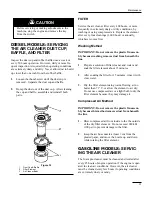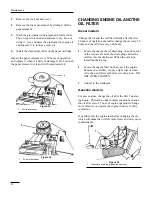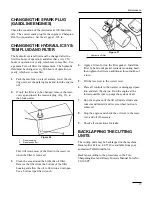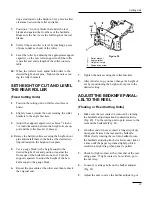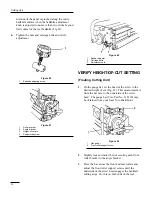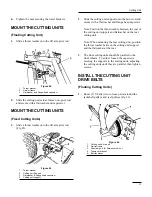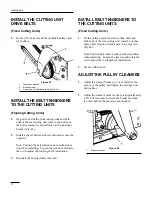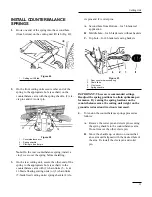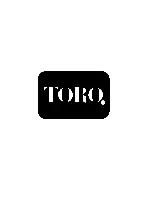
BEFORE MOWING
Inspect the area for debris and clear it if necessary.
Determine the direction best to mow on the previous
mowing direction. Always mow in an alternate pattern
from the previous mowing, so that the grass blades will
be less apt to lay down and therefore be difficult to gath-
er between the reel blades and bedknife.
OPERATING CHARACTERISTICS
Practice operating the Reelmaster and become thorough-
ly familiar with it. Because of its hydrostatic transmis-
sion and choices of either two or three wheel drive, its
characteristics differ from many turf maintenance
machines. Points to consider when operating are the
traction drive, engine speed and the load on the cutting
units. Regulate the traction pedal to keep the engine
rpm high and somewhat constant while mowing to main-
tain adequate power for the traction and cutting units.
Adjust the speed selector to maintain constant ground
speed and quality of cut. However, when on hilly ter-
rain, do not use the speed selector.
Follow the operating guidelines in this manual and know
how to operate the machine safely on all types of terrain.
Never traverse or mow up and down on slopes over 20
degrees, nor traverse or mow side hills in excess of 15
degrees. Always plan well ahead to avoid the need for
sudden stops, starts or turns. To stop, use the reverse
pedal for braking. Before stopping the engine, disen-
gage all controls, move the throttle to IDLE, and set the
parking brake.
TRANSPORT OPERATION
Be sure the cutting units are in the fully up position,
move the traction pedal stop from under the pedal to
allow full traction pedal travel and place the throttle con-
trol FAST. While operating on slopes and uneven ter-
rain, always reduce speed and use extreme caution
before turning to reduce risk of tipping or losing control.
Watch carefully for, and avoid, holes in the terrain, sud-
den drop-off s and other hidden hazards. To prevent
costly damage and downtime, familiarize yourself with
the width of the Reelmaster. Do not attempt to pass
between immovable objects placed close together.
INSPECTION AND CLEAN-UP
AFTER MOWING
After mowing, thoroughly wash the machine with a gar-
den hose—without a nozzle so excessive water pressure
will not cause contamination and damage to seals and
bearings.
Make sure the radiator screen, radiator and the oil cool-
er(diesel models) and cooling fins and area around the
engine cooling air intake (gasoline models) are kept free
of dirt or grass clippings. After cleaning, it is recom-
mended
–
the machine be inspected for possible hydraulic
fluid leaks, damage or wear to the hydraulic and
mechanical components
–
the cutting units be checked for sharpness and cor-
rect reel-to-bedknife adjustment.
CUTTING UNIT
CHARACTERISTICS
The single-knob, bedknife-to-reel adjustment system
simplifies the adjustment needed to deliver optimum
mowing performance. The precise adjustment that is
possible gives the necessary control to provide a contin-
ual self-sharpening action—thus maintaining sharp cut-
ting edges, assuring good quality-of-cut, and greatly
reducing the need for routine backlapping.
Also, the rear roller positioning system permits optimum
bedknife altitude and location for varying cutting heights
and turf conditions.
CUTTING UNIT DAILY
ADJUSTMENTS
Before each day’s mowing, or as required, check each
cutting unit to verify correct bedknife-to-reel contact.
This must be performed even though quality of cut is
acceptable.
1.
Shut off the engine and lower the cutting units onto
a hard surface.
21
Operating
Summary of Contents for reelmaster 216
Page 24: ...Figure 28 Figure 29 Figure 30 Figure 31 24 Maintenance ...
Page 34: ......
Page 35: ......
Page 36: ......



















